 |
 |
 |
|
January 2014
|
Nestled in the lush Maracas Valley at St Joseph is the pristine estate called Ortinola. The original Ortinola Estate spanned 430 acres or approximately 174 hectares and was created by a Spanish colonial land grant between the year 1780 and 1800. The name Ortinola, however, was given to the Estate in the 1830s by the Cipriani family (Cipriano and Sebastian) who came to Trinidad in response to the Cedula of Population issued in the 1780s by the King of Spain. The Ciprianis came from a hamlet in the north of Corsica called Ortinola. The Great House was built between 1870 and 1890 and is at least 120 years old, perhaps older. Ortinola was a thriving cocoa estate that supplied cocoa beans to Cadbury Brothers of Birmingham, England. Cadbury’s manager, Mr J.P. Bain, lived in the Great House with his family. The land was owned by Tennants Estates Ltd, a Scottish company owned by Lord Christopher Gray Tennant (aka Baron Glenconner) who either leased it to Cadbury or carried on a joint venture with them. Ownership changed hands over the years, with the current owners (Russell and Vindra Nath) acquiring the estate and the Great House in 1998, while looking for a farm to buy where they could keep a pony for their young daughter (Nikita) who loved horses. The Great House itself had been abandoned from around the 1960s when Tennants Estates sold the property to a local company (Ortinola Estates Ltd), which was owned by a group of Trinidadian businessmen.
Since December 2003, the Great House has been open for business as a family-run special-events venue, and this is where the relationship between the Cocoa Research Centre (CRC) and Russell and Vindra Nath started around ten years ago. The CRC (then the Cocoa Research Unit) contacted them to use Ortinola as a venue for a workshop and then various functions. I still vividly remember the first time we entered the road leading to Ortinola—time stood still and then started to rewind—then we entered the gates and collectively sucked our breaths in awe at the serene beauty that lay in front of us.
Enter the regional project, “Caribbean Fine and Flavour Cocoa Industry Commercialisation” funded by the Centre for Development of Enterprise (CDE), an EU/ACP institution in the region, with its headquarters in Brussels and regional office in the Dominican Republic. The aim of this project is to provide technical assistance to entrepreneurs within the cocoa sector in seven Caribbean countries (Belize, Commonwealth of Dominica, Dominican Republic, Haiti, Jamaica, Grenada, and Trinidad and Tobago) with the aim of improving the profitability of the regional cocoa industry, as well increasing regional exports. The overall goal of the project is to address the challenges faced by fine or flavour cocoa producers in the Caribbean: declining production and low productivity; as well as food safety and other quality concerns. In addition, the project promotes the development of value-added products and agri-tourism associated with cocoa production. These goals have been executed via the following components:
Technical assistance has been provided for each component. The CRC partnered with CDE in rolling out and implementing the initial step of this project regionally as well as executing Components 1 and 2. Component 5 is being executed in partnership with IICA.
In 2013, under Component 3 of this project, Nikita Nath and other beneficiaries from the region, received training in chocolate making at the CRC and also travelled to Grenada to spend some time at the Grenada Chocolate Company for expanded training in chocolate making. The activities of the CRC in the CDE project almost exactly tie into the medium and long term vision for Ortinola and according to the Naths, “It has always been our dream to get back into cocoa production as it is part of the estate’s history and heritage. We are also attracted by the high demand and niche- market potential for Trinidadian cocoa worldwide due to its fine flavor.” To do this, they are currently restoring a second historic structure on the site (the labourer’s cottage) with the same attention to detail as they paid to the Great House, and this will be used as a gift shop, tea (cocoa-tea) house, and starting point for planned tours. With guidance from the CRC they will also eventually restore the fermentary and drying house which will be used for processing their estate-origin cocoa beans. As one of the partners in the CRC’s Cocoa Germplasm Conservation Programme, they plan to rehabilitate many or all (“labour permitting”) of the remaining hectares of cocoa over the coming years. These existing trees would be of the It’s a busy time for such a serene setting and Russell Nath is thankful for the partnership. “The Cocoa Research Centre at UWI was instrumental in getting us started off and we have a close relationship with them.” It goes both ways. The CRC looks forward to continue working with the Naths to realise the vision and potential for a most wonderful place. This piece was prepared by Darin Sukha with support from Nikita Nath. Dr Sukha is a research fellow and food technologist at the Cocoa Research Centre, The UWI, St Augustine. |

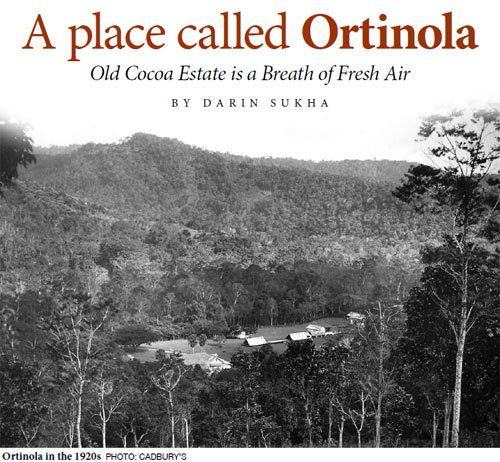
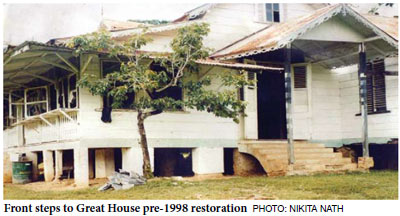 The estate now comprises 365 acres and the Great House took two years and two months to restore to its current state after decades of neglect. Today the Great House sits on an immaculately maintained 4-hectare parcel of land that combines colonial charm (complete with Morris chairs and other plantation-type furnishings) with modern amenities, making Ortinola the perfect location for hosting retreats, conferences, seminars, celebrations, family reunions and garden weddings. The bedrooms were converted into one of two conference rooms. Most of the building is in its original state and the building layout has been left exactly as it was to preserve the beauty of the Great House.
The estate now comprises 365 acres and the Great House took two years and two months to restore to its current state after decades of neglect. Today the Great House sits on an immaculately maintained 4-hectare parcel of land that combines colonial charm (complete with Morris chairs and other plantation-type furnishings) with modern amenities, making Ortinola the perfect location for hosting retreats, conferences, seminars, celebrations, family reunions and garden weddings. The bedrooms were converted into one of two conference rooms. Most of the building is in its original state and the building layout has been left exactly as it was to preserve the beauty of the Great House. 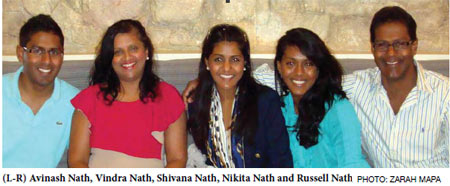 Russell and Vindra proved to be the most agreeable and accommodating hosts and were always willing to provide the best service despite our always limited budget. With each successive interaction their relationship with CRC evolved until we started talking about the current and future plans for Ortinola and how the current CRC project activities could help the Naths realize their vision.
Russell and Vindra proved to be the most agreeable and accommodating hosts and were always willing to provide the best service despite our always limited budget. With each successive interaction their relationship with CRC evolved until we started talking about the current and future plans for Ortinola and how the current CRC project activities could help the Naths realize their vision. 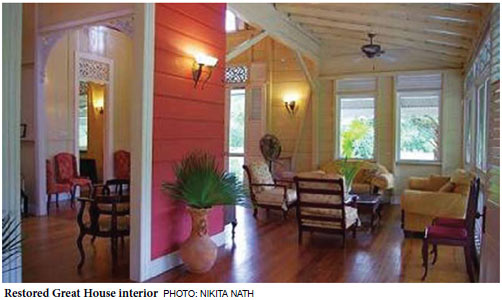 The Ortinola Estate is one of the beneficiaries of this project under Components 1, 3 and 5, receiving technical assistance via Farmer Field School (FFS) training in cocoa production and post-harvest processing, as well as advice on exploring the huge cocoa agri-tourism potential at Ortinola. Indeed the 6,000 trees of Trinidad Select Hybrid (TSH) cocoa plants, planted in August 2012, and the Great House have served as a wonderful venue for many of the FFS sessions.
The Ortinola Estate is one of the beneficiaries of this project under Components 1, 3 and 5, receiving technical assistance via Farmer Field School (FFS) training in cocoa production and post-harvest processing, as well as advice on exploring the huge cocoa agri-tourism potential at Ortinola. Indeed the 6,000 trees of Trinidad Select Hybrid (TSH) cocoa plants, planted in August 2012, and the Great House have served as a wonderful venue for many of the FFS sessions. 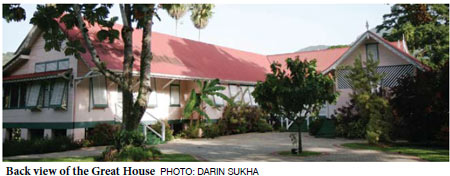 older varieties, planted when the estate was still producing cocoa in the 1930s. Their desire is to preserve these older ‘heirloom’ varieties, and together with the newly planted cocoa trees that should start bearing by May 2015, eventually produce Ortinola-branded chocolate bars and other cocoa products. Also on the cards are lodge/cabin accommodation in the future, built using the same architectural style of the existing Plantation Great House. There is the potential for horseback riding, nature trails and many other activities to keep guests occupied whilst learning about the ‘tree-to-bar’ manufacture of Ortinola-origin chocolate.
older varieties, planted when the estate was still producing cocoa in the 1930s. Their desire is to preserve these older ‘heirloom’ varieties, and together with the newly planted cocoa trees that should start bearing by May 2015, eventually produce Ortinola-branded chocolate bars and other cocoa products. Also on the cards are lodge/cabin accommodation in the future, built using the same architectural style of the existing Plantation Great House. There is the potential for horseback riding, nature trails and many other activities to keep guests occupied whilst learning about the ‘tree-to-bar’ manufacture of Ortinola-origin chocolate.